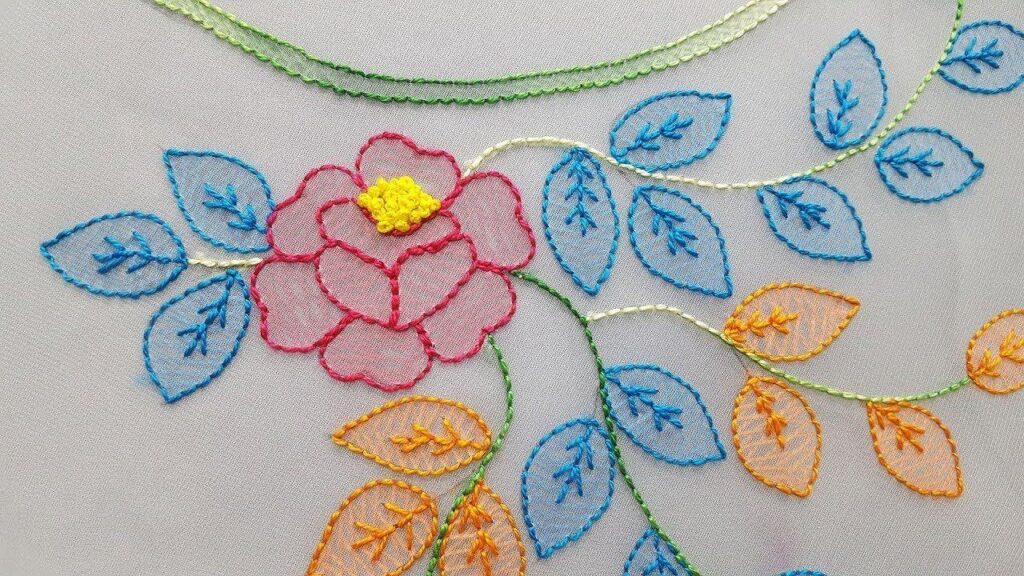Today in this blog, we will talk about the most basic and common hand embroidery stitches. Whether you are new to this game or have been working in this field for years, these stitches come in handy to both. Let’s get started.
Satin Stitch and Variations
Basic, flat stitch is a simple and delightful filling stitch that will be wont to fill smaller areas. Other variations of the stitch include the long and short stitch, which is beneficial for filling larger areas or creating a shaded look, and the padded stitch, which has stitching underneath to make a thicker stitch.
French Knot
The French knot is often overwhelming stitchers but is straightforward to figure after a touch of practice.
Cross Stitch—Chinese
It makes a reasonably border or edging on a project, and may be worked during a single row or multiple rows. The stitching area is often pre-marked on the material, worked freestyle, or worked as a counted stitch.
Blanket stitch
Blanket stitch may be a basic stitch that will be worked as a surface embroidery stitch, as an edging, or to applique elements in situ on an embroidery project. it’s worked using open half-loops of sewing, almost like a hand-worked stitch.
Chevron Stitch
Chevron stitch may be a surface embroidery stitch worked using long diagonal stitches topped with a horizontal cap stitch. These stitches are often utilized in straight rows and bands. It also can be stitched along a curved edge if guidelines are carefully marked on the material.
Colonial Knot
The colonial knot looks almost like a French knot, but it’s a tighter and sturdier knot utilized in surface embroidery, especially candlewick embroidery.
Coral Stitch
Coral stitch, sometimes called a coral knot, maybe a knotted stitch worked along a line. The result’s a textured line with a rather bumpy look. you’ll work the individual stitches or knots approximate or with some space between them to vary the design of this stitch.
Couching Stitch
Use a couching stitch when working with embroidery threads, yarns, or ribbons that you simply want to go away on the surface of the material. instead of working the most thread through the fabric, this stitch essentially tacks the most thread into place. you’ll also use a couching stitch for filling a neighborhood with texture.
Cretan Stitch—Open
Open Cretan stitch is analogous to feather stitch, because it uses interlocking curved stitches, but is formed using stitches that are vertical along the highest and bottom edges, instead of curved. It is often wont to outline shapes, as a border, or to hitch two pieces of fabric together employing a decorative, open lacy stitch.
Cross Stitch—Long-Armed or Elongated
The long-armed cross stitch, sometimes mentioned as an elongated cross stitch, is often worked in bands and rows, or to stipulate or frame a neighborhood of a design in counted thread embroidery projects. When worked in rows, the stitches cross one another and resemble a braid.
Chain Stitch and Variations
The basic chain stitch is beneficial for working bold lines of embroidery. There are two ways to figure the stitch: forward and reverse. Choose the tactic you discover easier. Chain stitch also makes a superb fill stitch, covering an outsized area quickly.
Chain Stitch—Detached or Lazy Daisy
Learn to figure one, detached chain stitch. You’ll use this teardrop or petal-shaped stitch frequently as accents, scattered fill stitching, and altogether sorts of floral embroidery.
Feather Stitch & Variations
Feather stitch is light and airy, creating an open line of embroidery stitching that will be used for borders, around shapes, or to connect appliques.
Fern Stitch
The fern stitch may be a surface embroidery stitch to create an open, lacy stitch along a straight or curved line. It’s beautiful and worked as tree branches, ferns, or seaweed during a project. Each section of the fern stitch is worked as a gaggle of three straight stitches, all worked into an equivalent ending hole. The groups are stitched repeatedly to form a row.
Fly Stitch
Fly stitch may be a surface embroidery stitch that will be worked in several ways. As one stitch, you’ll alter the design of it, including making curved or scalloped stitching. it is also useful for fill stitching or making an ornamental line.
Herringbone Stitch
These lines are often marked otherwise you can count the threads in your fabric to space the stitches.
Back Stitch
The backstitch may be a basic embroidery and sewing stitch want to produce a skinny line of sewing, to stipulate shapes which will be crammed with stitch, or to stitch fabric pieces together.
Chain Stitch—Feathered
The feathered chain stitch maybe a decorative hand embroidery stitch that utilizes detached chain stitches arranged during a zig-zag pattern as if working the feather stitch, forming a hybridized stitch. This highly textured surface embroidery stitch is wider than a typical chain stitch, making it perfect to be used in wide bands and rows.
Conclusions
These are some of the best and most common stitches used in hand embroidery. Once you get familiar with these stitches, you make embellishing embroidery designs with ease. If you still have any questions about the topic or anything related to embroidery digitizing, feel free to reach out to us at Migditizing.
Thanks For Reading
More Read On Usamagazine

